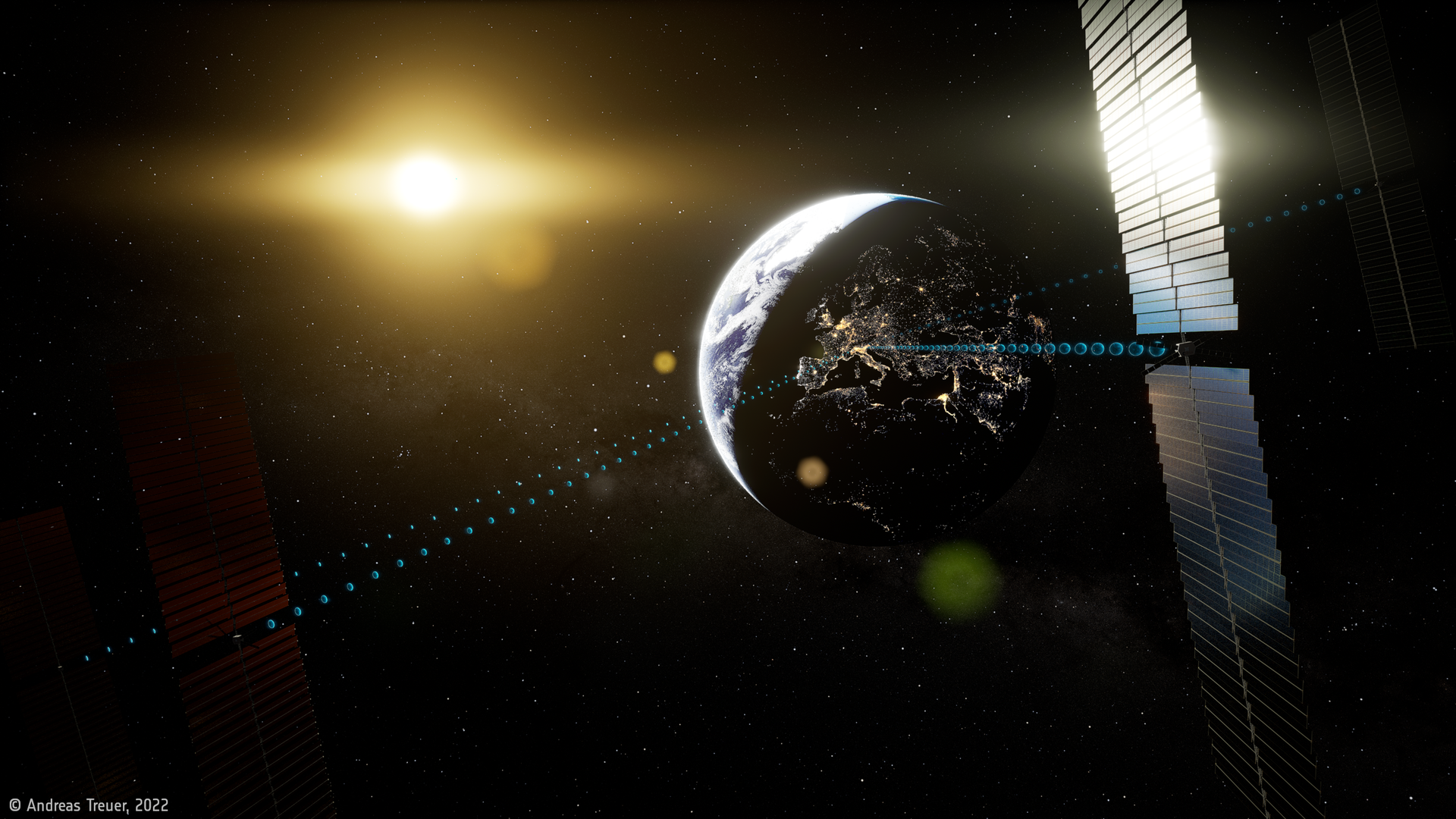ESA accelerates the race towards clean energy from space
ESA - ESA accelerates the race towards clean energy from space European Space Agency


SOLARIS: Space-Based Solar Power for Earth’s Energy Needs
Agency
15/04/2024 | 376 views | 6 likes

ESA is laying the groundwork for the development of satellite technology designed to harvest the Sun’s energy in space before transmitting it wirelessly to receiving stations on Earth.
The initiative, named SOLARIS, raises the tantalising prospect of clean, scalable energy beamed down continuously from orbit to back up weather-dependent renewables and eliminate reliance on fossil fuels.
Through SOLARIS, ESA is bringing together policymakers, energy suppliers, and space companies to investigate the feasibility of developing and implementing space-based solar power. This is intended to enable Europe to make an informed decision by the end of 2025 on proceeding with a development program dedicated to the technology.
Humanity’s energy problem
The energy industry – particularly coal, oil, and gas – is a strong contributor to the climate crisis. In an effort to mitigate these impacts, Europe is advancing a transition to renewable power sources with the aim of reaching carbon neutrality by 2050.
Sanjay Vijendran, ESA’s lead for the SOLARIS initiative, says, “Net zero presents many challenges, including the fluctuating outputs of current renewables like wind and ground-based solar farms.
“Looking beyond 2050, the energy requirements of developing nations are expected to rise significantly. This, coupled with intensifying climate impacts, means the need for renewable and reliable sources of power, that can also be scaled up sufficiently, will become ever more pressing.”
Given the uninterrupted nature and scalable potential of space-based solar power, the technology could offer a solution to these current and future energy challenges.
The idea is to collect solar energy in space, where it is continuously available and unaffected by cloud cover or other atmospheric conditions. It is then transmitted wirelessly down to strategically placed receivers connected to the energy grid.
Defining the concept
In 2023 a SOLARIS study led by Thales Alania Space Italy, with contributions from renewable energy company ENEL, began to draw up an early definition of a space-based solar power system that uses radio waves to deliver a reliable 24/7 supply of energy to the ground.
Sanjay, who will present SOLARIS this week at the International Conference on Energy from Space in London, explains, “The physics behind this design is already implemented in telecommunications, where satellites beam small amounts of energy in the form of radio-frequency waves from orbit to a receiving ground station.
“The difference with space-based solar power is that the amount of energy transmitted and successfully collected would need to be far larger to make the venture viable – this presents many technological hurdles to be overcome.”
A further SOLARIS study – led by consultancy Arthur D Little in collaboration with energy supplier ENGIE – is investigating a secondary concept that could serve as a forerunner to radio-frequency solar power satellites.
This type of system uses large mirrors deployed in space to reflect sunlight down through the atmosphere to existing terrestrial solar farms, boosting their yields and enabling them to continue producing energy even at times when natural light levels are low.
The reflector design poses fewer technical challenges than the radio-frequency concept, meaning that it could be implemented earlier to test technologies that are eventually used in radio-frequency solar power constellations.
Future work will address the challenges of space-based solar power, several of which are related to the anticipated scale of both the solar farms in space and the receiving stations on the ground.
With solar power constellations expected to measure hundreds of meters or even kilometers across, engineers will need to find ways to assemble, maintain, and operate these systems, while mitigating risks posed by orbital debris and space weather.
Sanjay adds, “The challenges associated with space-based solar power are looking more surmountable than ever, thanks to low-cost reusable launch systems, and advances in robotics, in-orbit servicing technologies, and wireless power transmission.”
New opportunities
Alongside the system concept studies, SOLARIS is enabling science and technology development that will be integral to future space-based solar power infrastructure. The findings from this work could also be useful for many other space-based and terrestrial applications.
ESA, with dedicated funding from the UK Space Agency, recently invited British companies to develop robotics systems that could be used for the assembly, maintenance, or operation of solar farms in space.
ESA will also work with academic partners on a series of science studies to investigate important research questions, including how radio waves used in space-based solar power will behave in Earth’s atmosphere, and how they could impact human health and natural ecosystems.
A further aim of SOLARIS is to bring together the space industry, energy companies, and governments to explore the enormous potential of solar power satellite technology in their collective push towards decarbonizing society in the next decades.
This effort will be on show this week at the International Conference on Energy from Space, which is set to welcome key figures from the UK government and the energy industry to discuss SOLARIS and other related activities in the UK, Europe, and beyond.
Sanjay concludes, “The threat of the climate crisis demands that we work together to explore alternative technologies to achieve carbon neutrality – and
SDGs, Targets, and Indicators
-
SDGs Addressed or Connected to the Issues
- SDG 7: Affordable and Clean Energy
- SDG 9: Industry, Innovation, and Infrastructure
- SDG 13: Climate Action
The article discusses the development of space-based solar power technology as a solution to the energy challenges faced by humanity. This aligns with SDG 7, which aims to ensure access to affordable, reliable, sustainable, and modern energy for all. It also connects to SDG 9, which focuses on promoting sustainable industrialization and fostering innovation. Additionally, the article highlights the role of space-based solar power in mitigating the impacts of the energy industry on climate change, linking it to SDG 13, which targets urgent action to combat climate change and its impacts.
-
Specific Targets Based on the Article’s Content
- Target 7.2: Increase substantially the share of renewable energy in the global energy mix
- Target 9.1: Develop quality, reliable, sustainable, and resilient infrastructure
- Target 13.2: Integrate climate change measures into national policies, strategies, and planning
The article emphasizes the potential of space-based solar power to contribute to increasing the share of renewable energy in the global energy mix (Target 7.2). It also highlights the need for reliable and resilient infrastructure to support the development and implementation of this technology (Target 9.1). Furthermore, the article discusses the role of space-based solar power in addressing climate change and integrating climate change measures into national policies and planning (Target 13.2).
-
Indicators to Measure Progress
- Indicator 7.2.1: Renewable energy share in the total final energy consumption
- Indicator 9.1.1: Proportion of the rural population who live within 2 km of an all-season road
- Indicator 13.2.1: Number of countries that have integrated mitigation, adaptation, impact reduction, and early warning measures into their national policies, strategies, and planning
The article suggests that the development and implementation of space-based solar power technology could contribute to increasing the renewable energy share in the total final energy consumption (Indicator 7.2.1). It also highlights the need for infrastructure development to support this technology, which can be measured by the proportion of the rural population living within 2 km of an all-season road (Indicator 9.1.1). Additionally, the article emphasizes the importance of integrating climate change measures into national policies and planning, which can be measured by the number of countries that have achieved this integration (Indicator 13.2.1).
Table: SDGs, Targets, and Indicators
| SDGs | Targets | Indicators |
|---|---|---|
| SDG 7: Affordable and Clean Energy | Target 7.2: Increase substantially the share of renewable energy in the global energy mix | Indicator 7.2.1: Renewable energy share in the total final energy consumption |
| SDG 9: Industry, Innovation, and Infrastructure | Target 9.1: Develop quality, reliable, sustainable, and resilient infrastructure | Indicator 9.1.1: Proportion of the rural population who live within 2 km of an all-season road |
| SDG 13: Climate Action | Target 13.2: Integrate climate change measures into national policies, strategies, and planning | Indicator 13.2.1: Number of countries that have integrated mitigation, adaptation, impact reduction, and early warning measures into their national policies, strategies, and planning |
Behold! This splendid article springs forth from the wellspring of knowledge, shaped by a wondrous proprietary AI technology that delved into a vast ocean of data, illuminating the path towards the Sustainable Development Goals. Remember that all rights are reserved by SDG Investors LLC, empowering us to champion progress together.
Source: esa.int

Join us, as fellow seekers of change, on a transformative journey at https://sdgtalks.ai/welcome, where you can become a member and actively contribute to shaping a brighter future.







